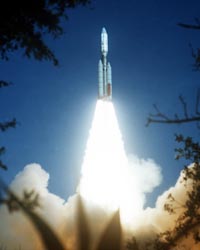Today NASA celebrates the 30th anniversary of the launch of its amazingly successful Voyager spacecraft. My, how time flies.
The Voyager mission came about because, in the mid-1960s, a Caltech graduate student and budding Jet Propulsion Laboratory engineer named Gary Flandro chanced upon a shortcut to the outer solar system. Every 176 years, Flandro discovered, worlds align in such a way that a spacecraft flying past Jupiter can be accelerated and redirected toward all the other outer planets. By exploiting this opportunity, space scientists could complete a "grand tour" of Jupiter, Saturn, Uranus, Neptune, and even Pluto in just 12 years. The catch? The alignment was brief, and the launch would have to occur before 1978.
Regrettably, NASA had to abandon this marvelous go-for-broke opportunity because it was deemed too expensive by higher-ups. Voyagers 1 and 2 were the consolation prizes. In fact, recalls project scientist Ed Stone, the mission's funding was so tight that Voyager 2's flyby of Saturn had to take place before June 30, 1981 — the end of NASA's fiscal year!
So, officially, NASA never intended for the Voyagers to go to Uranus and Neptune. But JPL's rocketeers managed to fortify the craft with some cutting-edge technologies anyway, like a high-frequency radio transmitter and image-compression algorithms, to at least keep the dream alive.

Voyager 2's launch on August 20, 1977.
NASA
On August 20, 1977, a Titan-Centaur rocket rose into the blue sky over Cape Canaveral, Florida, sending Voyager 2 on its way. It was a beautiful, flawless launch.
Voyager 1's launch took place 16 days later, on September 5th, when the planetary alignment was better for reaching Jupiter and Saturn — but by which time the Uranus-Neptune trajectory "window" had closed.
In a little-known footnote to space history, Voyager 1's Titan booster shut down prematurely after liftoff. The powerful Centaur upper stage was barely able to compensate, reaching escape velocity 3.4 seconds before running out of fuel. Luckily, Voyager 1 would still reach Jupiter and Saturn as planned.
However, had the underachieving Titan been used instead for Voyager 2, whose trajectory hinged on getting maximum performance from its booster, its eventual encounters with Uranus (in 1986) and Neptune (in 1989) would have been lost. By pure chance, Voyager 2 got the better rocket.
Both craft continue to operate and set records for long-distance communication. Voyager 1 is an astounding 9.6 billion miles (103 astronomical units) from the Sun; Voyager 2 is 7.8 billion miles (83 a.u.) away. With a little luck, in the coming years Voyager 1 may pass through the heliosheath, the outer vestige of the Sun's magnetic influence, and make it to true interstellar space.
 5
5
Comments
Christopher Dube
August 24, 2007 at 1:10 pm
Another little known fact about Voyager 1 is we would have pictures of the PLANET PLUTO right now if NASA had not decided to do a flyby of SATURN'S Moon TITAN instead.
You must be logged in to post a comment.
Philip E. Evans
August 27, 2007 at 10:16 pm
Another little know fact about the Voyager 2 launch was that just moments before the launch, all six computers that comprised the Primary Telemetry System for Voyager at JPL went down. This caused a hold on the launch while all six computers were reloaded and the telemetry system was resynronised. I was the Sr. Data Operator that morning on the Voyager Primary Telemetry System at JPL in the Telemetry and Command Operations (TCO) Center.
You must be logged in to post a comment.
Kelly Beatty
August 28, 2007 at 5:35 am
I asked Ed Stone, Voyager's Project Scientist, whether sending Voyager 1 to Pluto (instead of redirecting it to Titan, which is what occurred) was ever seriously considered. Here's his response, in part:
"Mission success was keyed to studies of Titan and the rings. That meant a close Titan flyby with an atmospheric radio occultation and flying behind Saturn's rings for a radio occultation study of the rings.... [To do so] Voyager 1 had to fly by Saturn at a specific angle to the ecliptic plane and at a specific distance from Saturn, sending Voyager 1 in a different direction than toward Pluto. The Voyager 1 trajectory was referred to as JST.
"The Voyager 2 trajectory was labeled JSX, with X=U or X=T depending on the success of Voyager 1 at Saturn. If Voyager 1 was successful, Voyager 2 would fly by Saturn in the ecliptic plane toward Uranus, forgoing the Titan and ring occultations. However, if Voyager 1 had not met the key Saturn objectives, Voyager 2 would have been retargeted to repeat the Voyager 1 flyby geometry. Fortunately, Voyager 1 was successful in November 1980, and soon thereafter NASA
HQ approved Voyager 2 continuing on the JSU trajectory."
You must be logged in to post a comment.
Rusty Osborne
August 29, 2007 at 8:09 am
What power supply systems do the Voyagers use to allow continued operation of instruments and high-frequency radio after 30 years?
Rusty Osborne
Austin, TX
They are powered by miniature plutonium-fueled nuclear reactors called Radioisotope Thermoelectric Generators (RTGs). Cassini and New Horizons use them too. Each Voyager's set of RTGs is still pumping out about 285 watts of electricity, but the output slowly declines over time. — Kelly Beatty
You must be logged in to post a comment.
John W
August 30, 2007 at 10:05 am
Do the probes continue to send data back, and what form is it in?
Both are sending back data on magnetic fields and charged particles at the edge of the Sun's electromagnetic realm. Check out the website linked in the story to learn more about this amazing success story! — Kelly Beatty
You must be logged in to post a comment.
You must be logged in to post a comment.